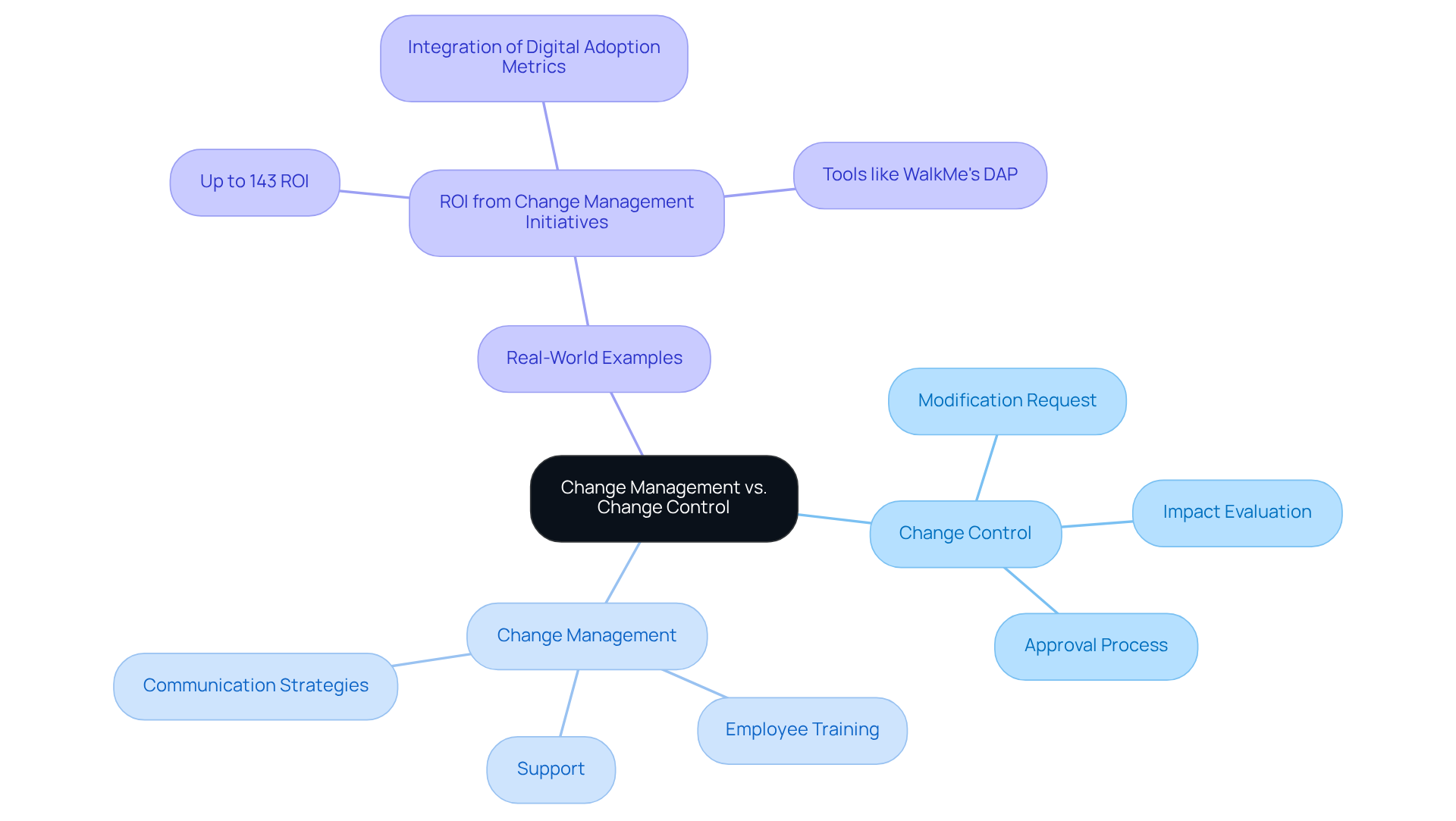
Building a Documentation Culture
|
October 17, 2025
|
Understanding the Difference Between Change Control and Change Management
Overview
You might be wondering what the main difference is between Change Control and Change Management. Well, it’s all about focus! Change Control is like a systematic process that helps track and approve changes to projects. On the flip side, Change Management is more about preparing and supporting people as they navigate through organizational transitions.
The article does a great job of illustrating this distinction. It details how Change Control relies on formal documentation and getting stakeholders involved. Meanwhile, Change Management shines a light on communication strategies and keeping employees engaged to make sure transformations happen smoothly. Now, doesn’t that make you think about how you handle changes in your own projects?
Key Highlights:
- Change Control is a systematic process for tracking changes to projects, ensuring documentation, evaluation, and approval before implementation.
- Change Management focuses on preparing and supporting individuals through organisational transitions, addressing the human and cultural aspects of change.
- Effective transformation management is critical for organisational success, especially in a rapidly changing technological landscape.
- Historically, Change Control emerged in the mid-20th century, while Change Management developed in the 1960s, emphasising employee engagement.
- Statistics show only one-third of transformation initiatives succeed, highlighting the importance of effective oversight.
- Organisations excelling in transformation management can see up to a 3.5% revenue increase over three years.
- Key characteristics of Change Control include formal change requests, comprehensive documentation, and stakeholder involvement.
- Change Management emphasises communication strategies, stakeholder engagement, and training programmes to facilitate smooth transitions.
- Real-world examples demonstrate that effective Change Management during mergers can yield high returns on investment, up to 143% ROI.
- The interrelationship between Change Control and Change Management enhances an organisation's adaptability, combining technical and human elements of change.
Introduction
You might be wondering why understanding the intricacies of organizational change is so crucial in today's fast-paced world. After all, adaptability can truly make or break a business. While change control and change management are often tossed around as if they mean the same thing, they actually play distinct yet complementary roles in guiding organizations through transitions.
In this article, we'll dive into the nuances of these processes and show you how mastering both can really boost project success and create a culture of resilience. But what happens when organizations overlook these differences? The fallout can be more severe than you might think, leading to chaos instead of cohesion during those critical transformations. So, let’s explore this together!
Define Change Control and Change Management
You might be wondering what Modification Control really is. Well, it’s a systematic process that keeps track of changes to a project, product, or system. This ensures that every adjustment is carefully documented, evaluated, and approved before it goes live. Think of it as a safety net that highlights the technical side of modifications, looking at how they could affect scope, timelines, and resources. For example, when a project team considers a big design change—like switching from a three-door to a five-door car—they need to look at various elements like design, budget, materials, and timelines. It’s all about understanding the full impact of that change. And here’s the kicker: Control of Modifications isn’t a solo act; it requires chatting and collaborating with stakeholders to make sure everything aligns with the bigger picture of the organization.
Now, let’s switch gears and discuss the difference between change control and change management. This one takes a broader view, focusing on how to prepare, support, and guide people through transitions in an organization. Understanding the difference between change control and change management is crucial for addressing the human and cultural sides of change, ensuring that everyone is involved and that the shift is smooth and effective. Effective transformation strategies often include clear communication, training programs, and initiatives that help leaders develop the skills they need to guide their teams. As Kelsey Miller wisely points out, 'When considering your choices for training, look for a program that corresponds with your personal and professional objectives; for instance, one that highlights organizational transformation.'
The importance of keeping an eye on transformation in organizations is huge, especially as we head into 2025. Companies are facing rapid technological changes and shifting market dynamics. Those that prioritize effective transformation management are in a better spot to adapt and thrive in this ever-changing landscape. Keeping a detailed record of changes in the control process is key; it not only provides a clear picture of what’s been modified but also fosters transparency and accountability, which can lead to greater success. Plus, being aware of potential challenges and crafting strategies to tackle them before launching an initiative can really boost the effectiveness of your change efforts. So, are you ready to dive into this world of transformation?

Explore the Historical Context and Importance
You might be wondering where Modification Control comes from. Well, its roots trace back to management practices in the mid-20th century, when the need for structured processes to handle changes became super clear. This approach was key for keeping disruptions to a minimum and ensuring project integrity. Now, on the flip side, Change Management started to carve out its own identity in the 1960s, focusing on the human side of transformation. Organizations began to realize that successful transitions rely heavily on employee engagement and support—after all, who wants to face resistance when trying to adopt new changes?
Statistics reveal that only about one-third of transformation initiatives actually succeed. That’s a tough pill to swallow, isn’t it? Plus, 31% of CEOs find themselves out of a job due to poor oversight during transitions, underscoring just how crucial effective transformation management is for stable leadership. As the business landscape has shifted, both Modification Control and Change Management have gained a lot of attention. In today’s fast-paced world, having a handle on transformation oversight isn’t just a nice-to-have; it’s essential for success.
Did you know that companies excelling in transformation oversight see a whopping 3.5% revenue increase over three years? Meanwhile, those struggling with it often face a dip in profitability. And here’s something to think about: organizations that align their operational changes with solid transition strategies are 50% more likely to achieve long-term growth. It’s pretty clear that adopting open-source transformation management principles can boost success rates from 34% to 58%. This evolution in thought really highlights the difference between change control and change management, showing how essential it is to blend both to navigate the complexities of today’s organizational dynamics. So, what’s your take on this? How does your organization handle transformation?

Identify Key Characteristics and Components
You might be wondering about the key characteristics of Control of Modifications. Well, it starts with a formalized process for submitting requests for changes, along with comprehensive documentation of those modifications. Plus, there’s a structured approval process that actively involves stakeholders. To keep everything clear and accountable, tools like request forms and impact evaluations often come into play.
Now, let’s dive into Change Management. This approach really shines when it comes to effective communication strategies, robust stakeholder engagement, and targeted training programs. It also emphasizes the importance of systematic feedback mechanisms to help make transitions as smooth as possible. You see, having strong leadership support and a culture that embraces change is crucial. It creates an environment where transformations aren’t just tolerated—they’re welcomed!
Thriving organizations totally get that blending these elements can supercharge transformation effectiveness. The result? Greater employee engagement and satisfaction. So, how can you incorporate these ideas into your own strategies? Let’s explore that together!

Examine Practical Differences and Real-World Examples
You might be wondering what the difference between change control and change management is, right? Let’s break it down. Change Control is often illustrated by a software development team rolling out a new feature. In this case, the team submits a modification request, evaluates how it will impact the project timeline, and secures the necessary approvals before diving into implementation. It’s mostly a technical process, focused on making specific modifications happen.
Now, let’s switch gears to Change Management. Imagine a company navigating a merger. Here, a thorough transformation approach kicks in. This includes communication strategies, employee training sessions, and ongoing support to help everyone adjust to the new corporate culture. This method tackles the bigger picture of transformation by addressing the difference between change control and change management, while shining a light on the human and procedural elements at play.
Real-world examples really highlight the importance of managing these transitions effectively. Companies that have rolled out strong change programs during mergers often see impressive returns on investment—some even hitting up to 143% ROI, according to McKinsey! By integrating digital adoption metrics with financial KPIs, organizations can track the value generated from these initiatives transparently. For instance, using digital adoption tools like WalkMe’s DAP can boost user support and make training scalable. Plus, phased rollouts during mergers allow companies to manage risks better and gather feedback before going all in, ensuring smoother transitions. This all points to the crucial role of Transition Management in driving successful organizational transformations.

The Interrelationship Between Change Control and Change Management
You might be wondering what the difference between change control and change management is and how they work together. Well, these two processes are like best friends that, when they team up, can really boost an organization’s adaptability, illustrating the difference between change control and change management.
- Modification Control lays down the essential framework and documentation needed to ensure that changes happen smoothly and with as little disruption as possible.
- Meanwhile, Change Management takes care of the human side of things, making sure everyone is on board and feels involved in the transformation.
- When organizations blend these two approaches, they’re much better equipped to handle complex changes, particularly by understanding the difference between change control and change management in managing both the technical and human aspects of transitions.
So, isn’t it time to explore how you can integrate these strategies in your own workflow?

Conclusion
You might be wondering about the difference between change control and change management, right? Understanding this distinction is crucial for navigating the complexities of organizational transformation. Change control is all about the systematic processes that document and evaluate modifications, making sure every change is thoroughly assessed for its impact on scope, timelines, and resources. On the flip side, change management focuses on the human side of things, preparing and supporting individuals through transitions to boost engagement and reduce resistance.
As we wrap up, let’s highlight some key insights that show why both processes matter.
- Change control gives you a structured framework for managing technical changes,
- while change management tackles the cultural and emotional aspects of transformation.
Looking back, it’s fascinating to see how both practices have evolved to meet the needs of modern organizations, emphasizing their vital roles in achieving successful outcomes. Plus, real-world examples reveal that organizations that effectively blend both approaches are much more likely to thrive during times of change.
So, here’s the takeaway: integrating change control and change management isn’t just a best practice; it’s a strategic must for organizations that want to adapt and thrive in a constantly changing landscape. By recognizing how these two processes interact, organizations can boost their adaptability, cultivate a culture of continuous improvement, and drive greater success. Taking the time to implement these strategies will lead to smoother transitions and stronger organizational growth. Now, doesn’t that sound like a plan?
Frequently Asked Questions
What is Change Control?
Change Control is a systematic process that tracks changes to a project, product, or system, ensuring that every adjustment is documented, evaluated, and approved before implementation. It assesses how modifications can impact scope, timelines, and resources.
How does Change Control work in practice?
In practice, Change Control involves collaboration with stakeholders to understand the full impact of changes. For example, if a project team is considering a significant design change, they must evaluate elements like design, budget, materials, and timelines.
What is the difference between Change Control and Change Management?
Change Control focuses on the technical aspects of managing changes, while Change Management addresses the human and cultural sides of transitions within an organization. Change Management involves preparing, supporting, and guiding people through these changes.
Why is effective Change Management important?
Effective Change Management is crucial because it enhances employee engagement and support, which are vital for successful transitions. It helps prevent resistance to change and ensures that shifts are smooth and effective.
What historical context is associated with Change Control and Change Management?
Change Control originated from mid-20th century management practices that emphasized structured processes to minimize disruptions. Change Management began gaining recognition in the 1960s, focusing on the importance of employee involvement during transitions.
What statistics highlight the challenges of transformation initiatives?
Statistics show that only about one-third of transformation initiatives succeed, and 31% of CEOs may lose their jobs due to poor oversight during transitions, emphasizing the need for effective transformation management.
How does transformation oversight impact a company's revenue?
Companies that excel in transformation oversight experience a 3.5% revenue increase over three years, while those struggling with oversight often see a decline in profitability.
What is the benefit of aligning operational changes with transition strategies?
Organizations that align their operational changes with solid transition strategies are 50% more likely to achieve long-term growth, highlighting the importance of integrating Change Control and Change Management.
How can open-source transformation management principles affect success rates?
Adopting open-source transformation management principles can increase success rates from 34% to 58%, demonstrating the value of blending Change Control and Change Management to navigate organizational complexities.
👍
What others are liking
5 Steps to outline your ideal documentation structure
5 MINS READ
Where to start the your journey of mapping out your ideal documentation structure, aligning it with the very heartbeat of your organization?
Defining a winning level of detail in your process
3 MINS READ
What is too much detail, and what is too little? This article described in that winning level detail about what detail is enough.





